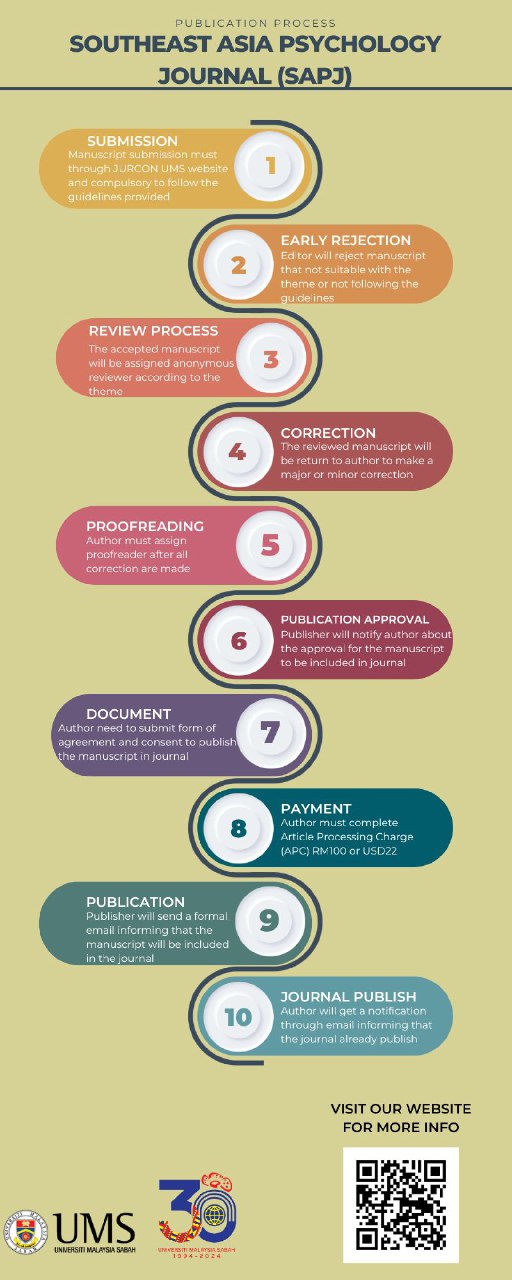THE EFFECT OF PARENTING STYLES, PERSONALITIES, BULLY BEHAVIORS TOWARDS SUICIDE ATTEMPT
DOI:
https://doi.org/10.51200/sapj.v11i2.4893Keywords:
Suicide Attempt, Bully, PersonalityAbstract
The aim of this study is to identify the association between parenting styles, personality, bullying behavior, and suicide attempt among adolescents in Kota Kinabalu, Sabah. This study is a descriptive-correlation quantitative study that emphasizes the relevance of variable variation and its relationship with other variables. Statistical analysis showed good reliability and validity of the research instruments. The reliability of the Parental Authority Questionnaire (PAQ) is .786; Big Five Inventory (BFI) is .702; the Measure of Bullying Behaviour-Adaptation (MBBS-A) is .824; and The Suicide Probability Scale (SPS) is .924. While the validity of all research instruments is good as the obtained value (p table) is greater than the critical value (r table) of .2542 and significantly high because < .05. The samples of the study were selected using the cluster sampling method and consisted of secondary school students in Johor. A total of 815 data were used for descriptive analysis while 659 data that had gone through the process of screening and normality analysis were used for inferential analysis. The findings showed that the level of suicide attempts among adolescents is high (45.6%). In addition, this study showed that the authoritative parenting style is the most dominant with a mean of 3.53; verbal bullying is the most dominant bullying behavior with a mean of 1.76; and agreeableness is the most dominant personality domain with a mean of 3.59. The results of the Stepwise-Multiple Regression analysis showed that social manipulation, verbal and, physical bullying behavior, agreeableness and conscientiousness in personality, and authoritative parenting styles are predictors of suicide attempts.
References
Ahmed, E. (2001). Shame Management: Regulating Bullying. Shame Management Through Reintegration. Cambridge: Cambridge University Press.
Allison, S., Pearce, C., Martin, C., Miller, K., & Long, R. (1995). Parental Influence, Pessimism and Adolescent Suicidality. Archives of Suicide Research. Retrieved from http://priory.com/adsui.htm#refer
Azizi Yahaya, Shahrin Hashim, Jamaludin Ramli, Yusof Boon, Abdul Rahim Hamdan, & Syed Mohamed Shafeq Syed Mansur Al-Habshi (2007). Menguasai Penyelidikan Dalam Pendidikan: Teori, Analisis & Interpretasi Data. Kuala Lumpur: PTS Professional Publishing Sdn. Bhd.
BRIS (2006). BRIS-rapporten. Samtal och meil till BRIS 2005. (The BRIS Report. Calls and Mails to BRIS 2005) www.bris.se (3-6-2006).
Cheng, S., & Chan, A. C. M. (2007). Multiple Pathways from Stress to Suicidality and The Protective Effect of Social Support in Hong Kong Adolescents. Suicide and Life-Threatening Behavior, 37, 187-196.
Demirbas, H., Celik, S., Ilhan, I. Ö., & Dogan, Y. (2003). An Examination of Suicide Probability in Alcoholic In-Patients. Alcohol & Alcoholism, Vol. 38, No. 1, 67-70.
Duck, J.R. (2004). Bully/Victim Relationships and School Violence Evaluation Patterns of Aggression. Thesis Doctor of Philosophy, Department of Adult Education and Counseling Psychology: University of Toronto.
Eisner, L. R. (2010). A Transdiagnostic Model of Suicidal Ideation and Suicide Attempts. Dissertation Doctor of Philosophy: University of Miami.
Eskin, M., Ertekin, K., Dereboy, C. & Demirkiran, F.,(2007). Risk Factors for and Protective Factors against Adolescent Suicidal Behavior in Turkey. Crisis, 28(3), xxx-xxx.
Eskin, M., Kaynak-Demir, H.,&Demir, S. (2005). Same-Sex Sexual Orientation, Childhood Sexual Abuse, and Suicidal Behaviour in University Students in Turkey. Archives of Sexual Behavior,34, 185–195.
Evans, E., Hawton, K., Rodham, K.&Deeks, J. (2005). The Prevalence of Suicidal Phenomenon in Adolescents: A Systematic Review of Population-Based Studies. Suicide and Life-Threatening Behavior, 35, 239–250.
Floor, J. (2009). A Graduate Level Course on Adolescent Suicide: Addressing Assessment, Intervention, and Postvention. Dissertation Doctor of Psychology, The Chicago School of Professional Psychology.
Forsman, A. (2003). Skolans texter mot mobbning.-reella styrdokument eller hyllvärrmare? (The school’s Texts Against Peer Bullying. Real Tools or Just Paper?) Doktorsavhandling. Luleå tekniska universitet: Institutionen för lärarutbildning.
Groholt, B., Ekeberg, O., Wichstrom, L., & Haldorsen, T. (2005). Suicidal and Nonsuicidal adolescents: Different Factors Contribute to Self-esteem. Suicide and Life-Threatening Behavior, 35(5), 525-535.
Groholt, B., Ekeberg, O., & Haldorsen, T (2006). Adolescent Suicide Attempters: What Predicts Future suicidal Acts? Suicide and Life-Threatening Behavior, 36(6),638-650.
Hall-Lande, J. A., Eisenberg, M. E., Christenson, S. L., & Neumark-Sztainer, D. (2007). Social Isolation, Psychological Hhealth, and Protective Factors in Adolescence. Adolescence, 42(166), 265-286.
Halling, W. B. (1988). Identification of Suicidal Risk In Adolescents. Thesis Degree Education Specialist, The Graduate School of Education: Drake University.
Harris, T. L., & Molock, S. D. (2000). Cultural Orientation, Family Cohesion, and Family Support in Suicide Ideation and Depression Among African American College Students. Suicide and Life-Threatening Behavior, 30, 341-353.
Herman, M. R., Dornbusch, S. M., Heron, M. C., & Herting, J. R. (1997). The Influence of Family Regulation, Connection, and Psychological Autonomy on Six Measures of Adolescents Functioning. Journal of Adolescent Research, 12, 34-67.
Hirst, S. D. (2010). An Idiographic and Phenomenological Approach to Understanding Suicide. Dissertation Doctor of Psychology, Department of Clinical Psychology: Antioch University New England.
Horesh, N., Gothelf, D., Ofek, H., Weizman, T., & Apter, A. (1999). Impulsivity as a Correlate of Suicidal Behavior in Adolescent Psychiatric Inpatients. Crisis: The Journal of Crisis Intervention and Suicide Prevention, 20(1), 8-14.
Ivarsson, T., Broberg, A., Arvidsson, T., and Gillberg, C. (2005). Bullying in Adolescence: Psychiatric Problem in Victims and Bullies as Measured by the Youth Self Report (YSH) and the Depression Self-Rating Scale (DSRS). Nordic Journal of Psychiatry, 59, 365-373.
Johnson, G.R., Krug, E.G., & Potter, L.B. (2000). Suicide Among Adolescents and Young Adults: A cross-National Comparison of 34 Countries. Suicide and Life-Threatening Behavior, 30,74–82.
Johnson, J. G., Cohen, P., Gould, M. S., Kasen, S., Brown, J., & Brook, J. S. (2002). Childhood Adversities, Interpersonal Difficulties, and Risk for Suicide Attempts During Late Adolescence and Early Adulthood. Archives of General Psychiatry,59, 741-749.
Johnston, R. (2004). A Review of Literature About Relational Aggression in School-Aged Girls. Master of Science Degree in Education: University of Wisconsin-Stout.
Joiner, T.E., Rudd, M.D., Rouleau, M.R.,&Wagner, K.D. (2000). Parameters of Suicidal Crises Vary as a Function of Previous Suicide Attempts in Youth Inpatients. Journal of the American Academy of Child and Adolescent Psychiatry, 39, 876–880.
Kisch, J., Leino, V., & Silverman, M.M. (2005). Aspects of Suicidal Behavior, Depression, and Treatment in College Students: Results from the Spring 2000 National College Health Assessment Survey. Suicide and Life-Threatening Behavior, 35,3–13.
Lewinsohn, P. M., Rohde, P., & Seeley, J. R. (1994). Psychosocial Risk Factors for Future Adolescent Suicide Attempts. Journal of Consulting and Clinical Psychology,62(2), 297-305.
Mills, C., Guerlin, S., Lynch, F., Daly, I., and Fitzpatrick, C. (2004). The Relationship Between Bullying, Depression and Suicidal thoughts/behavior in Irish adolescents. Irish Journal of Psychological Medicine, 21, 112-116.
Miller, A., Rathus, J., & Linehan, M. (2007). Dialectical Behavior Therapy With Suicidal Adolescents. New York: The Guilford Press.
Mohd Majid Konting (1998). Kaedah Penyelidikan Pendidikan. Kuala Lumpur: DBP.
Perkins, D. F. (2002). An Ecological Risk-Factor Examination of Suicide Ideation and behavior of adolescents. Journal of Adolescent Research, 17(1), 3-26.
Pontzer, D.P. (2007). Testing Reintegrative Shaming Theory as an Explanation for Involvement in Bullying Among University Students: Parenting, Personality and the Dyadic Relationship Between Bullies and Their Victims. Dissertation Doctor of Philosophy, Department of Criminology: Indiana University of Pennsylvania.
Randall, B. P., Wang, W. L., Herting, J. R., & Eggert, L. L. (2006). Family Factors Predicting Categories of Suicide Risk. Journal of Child and Family Studies, 15(3),255-270.
Reis, C. H. (2010). An Investigation of Suicide Risk and Counseling Participation Among College Students. Dissertation Doctor of Philosophy, The Graduate Faculty of The Curry School of Education: University of Virginia.
Rosenberg, M. (1989). Society and The Adolescent Self-Image. Revised Edition. Middletown, CT: Wesleyan University Press.
Salkind, N.L. (1997). Exploring Research. (3rd Ed.). New Jersey: Prentice-Hall Inc.
Salzinger, S., Rosario, M., Feldman, R. S., & Ng-Mak, D. S. (2007). Adolescent Suicidal Behavior: Associations with Preadolescent Physical Abuse and Selected Risk and Protective Factors. Journal of the American Academy of Child & Adolescent Psychiatry, 46(1), 859-866.
Sharaf, A. Y., Thompson, E. A., & Walsh, E. (2009). Protective Effects of Self-Esteem and Family Support on Suicide Risk Behaviors Among At-Risk Adolescents. Journal of Child and Adolescent Psychiatric Nursing, Vol. 22, No. 3, 160-168.
Simon, T. R., Swann, A. C., Powell, K. E., Potter, L. B., Kresnow, M., & O’Carroll, P. W. (2001). Characteristics of Impulsive Suicide Attempts and Attempters. Suicide and Life-Threatening Behavior, 32, 49-59.
Smith, K., & Crawford, S. (1986). Suicidal Behavior Among "Normal" High School Sstudents. Suicide and Life-Threatening Behavior, 16(3), 313-325.
Stewart, S.M., Lam, T.H., Betson, C., & Chung, S.F. (1999). Suicide Ideation and Its Relationship to Depressed Mood in a Community Sample of Adolescents in Hong Kong. Suicide and Life-Threatening Behavior, 29, 227–240.
Waldrop, A. E., Hanson, R. F., Resnick, H. S., Kilpatrick, D. G., Naugle, A. E., & Saunders, B. E. (2007). Risk Factors for Suicidal Behavior Among a National Sample of Adolescents: Implications for Preventions. Journal of Traumatic Stress,20(5), 869-879.
Wild, L.G., Flisher, A.J.,&Lombard, C. (2004). Suicidal Ideation and Attempts in Adolescents: Associations with Depression and Six Domains of Self-esteem. Journal of Adolescence, 27, 611–624.
Williams CL, Davidson JA, Montgomery I. (1980). Impulsive Suicidal Behavior. Journal of Clinical sychology, 36(1): 90-94.
Wilson, M. E. (2008). A Program Evaluation of Mindfulness-Based Stress Reduction as Experienced by Adolescent Male Bullies. Dissertation Doctor of Psychology, Faculty of the California School of Professional Psychology: Alliant International University San Diego.








